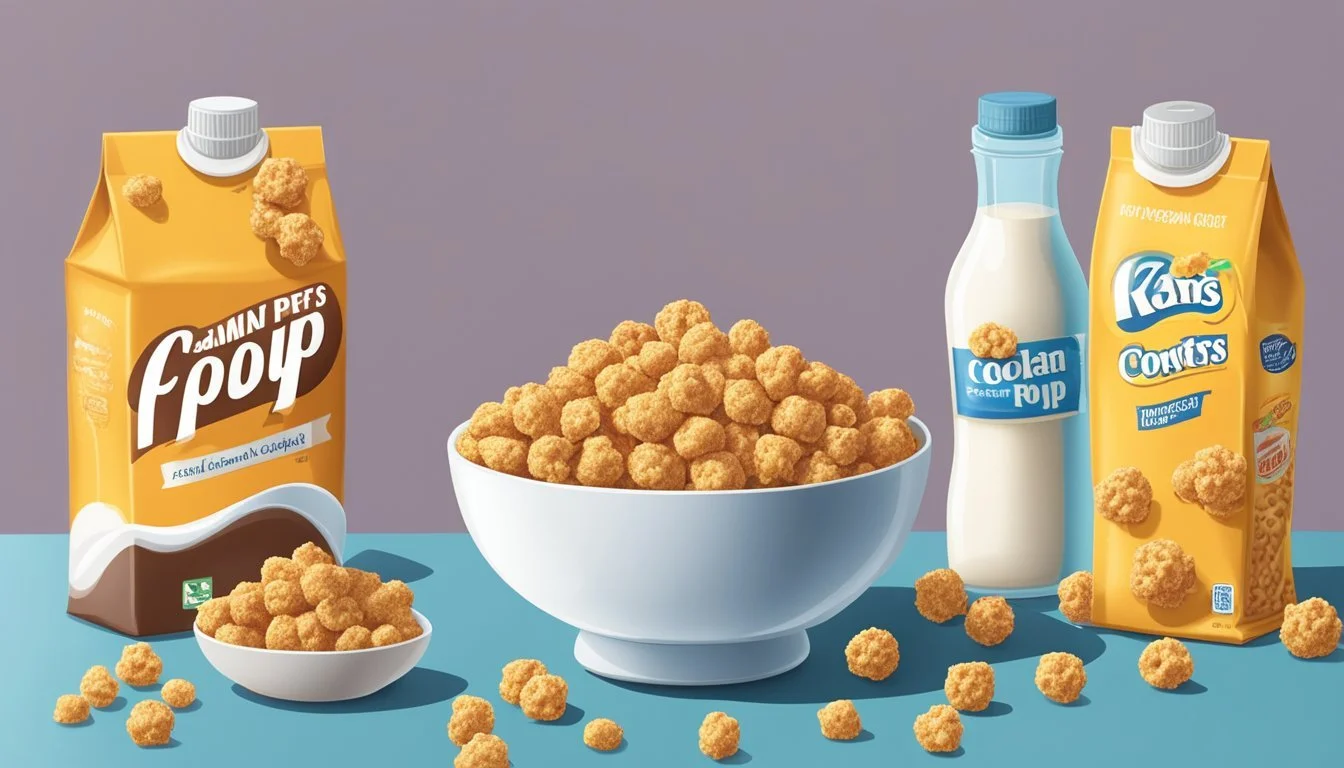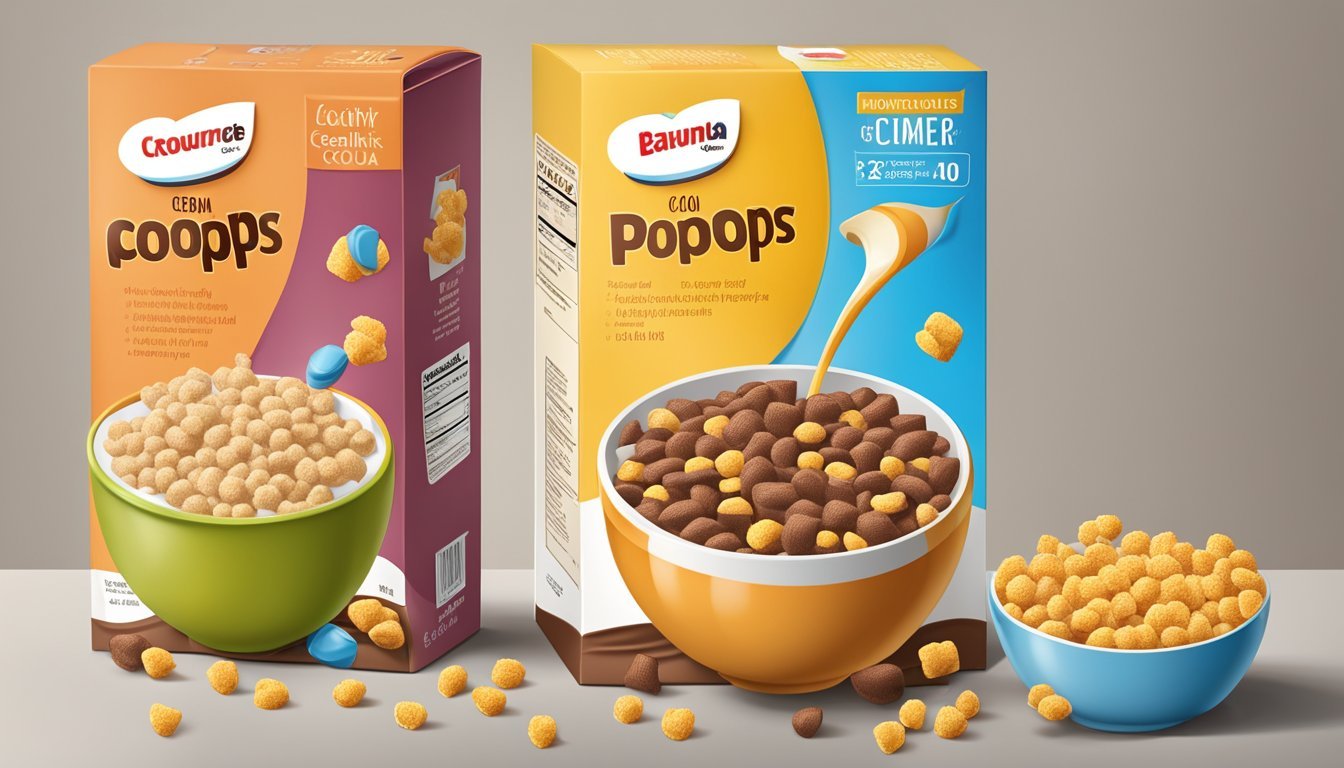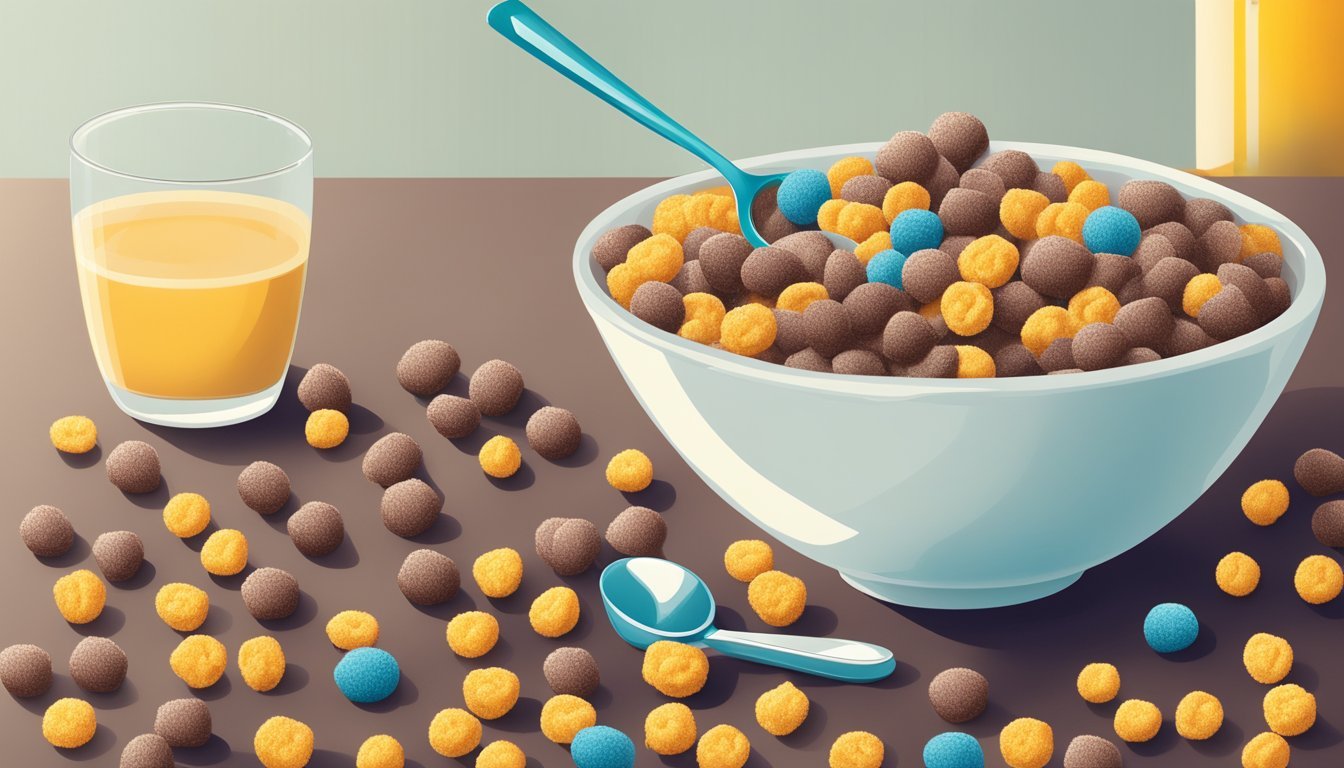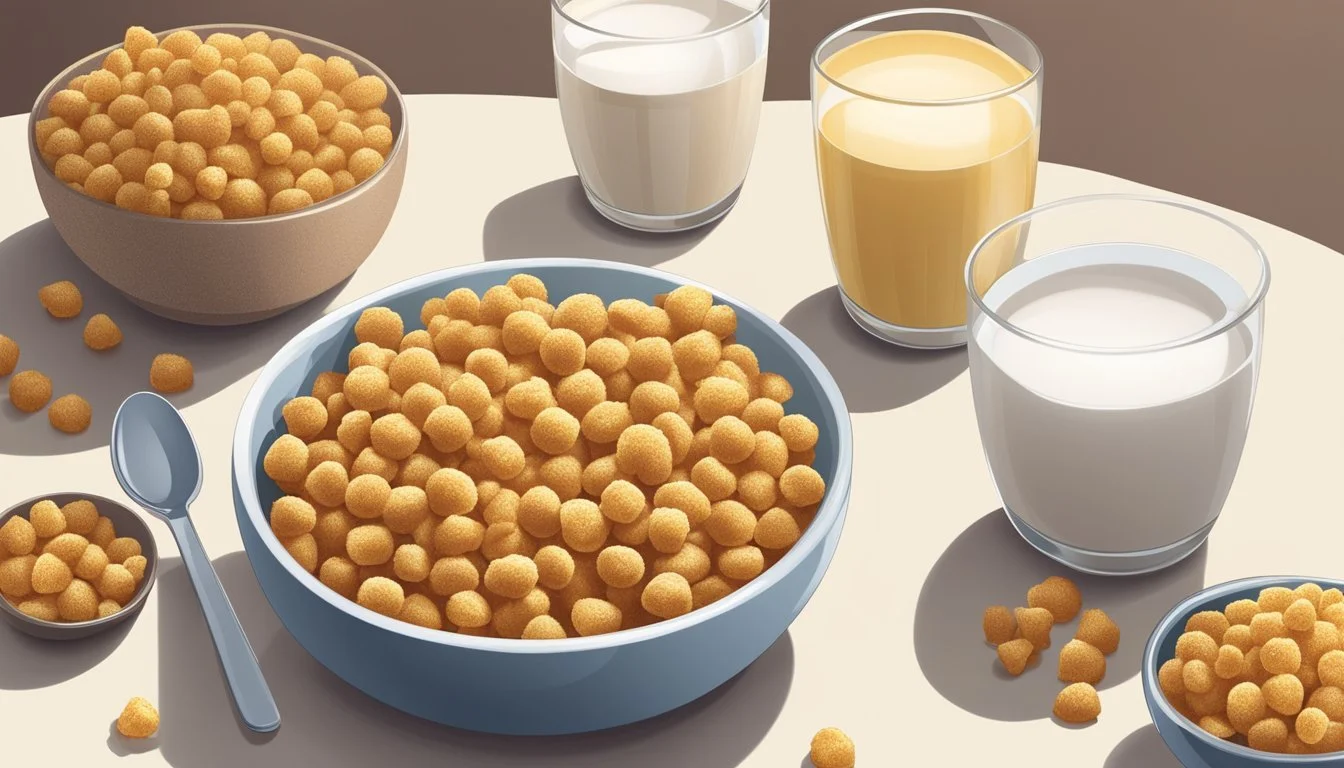Cocoa Puffs vs Corn Pops
Nutritional Comparison and Taste Review
This Article is Part of Our Breakfast Cereal Guide with Details on Cocoa Puffs Nutrition and Corn Pops Nutrition
When it comes to choosing between Cocoa Puffs and Corn Pops for breakfast, health-conscious consumers are often torn. Both cereals, produced by well-known brands General Mills and Kellogg's respectively, are popular choices for a quick and convenient meal. Cocoa Puffs, with their higher content of vitamins and minerals, might sway those looking for a nutrient boost, while Corn Pops offer a fiber advantage that is crucial for digestive health.
Diving into the nutritional specifics, Cocoa Puffs provide 12.0 grams of complex carbohydrates per serving, whereas Corn Pops slightly edge out with 13.0 grams. Although Cocoa Puffs are packed with essential nutrients like Iron and Zinc, Corn Pops remain a favorite for many due to their unique texture and flavor profile. The calorie count per serving is also a consideration, with Corn Pops containing 150 calories compared to the 100 calories in Cocoa Puffs, potentially making the latter a more weight-conscious option.
The choice ultimately hinges on individual nutritional needs and taste preferences. For those prioritizing a more vitamin-packed breakfast, Cocoa Puffs stand out. Meanwhile, Corn Pops offer the familiarity of a classic with the added benefit of higher fiber content.
Historical Background
The historical development of Cocoa Puffs and Corn Pops reveals their impact on the breakfast cereal market. General Mills introduced Cocoa Puffs, while Kellogg's created Corn Pops, each evolving uniquely over time.
Evolution of Cocoa Puffs
Cocoa Puffs, manufactured by General Mills, appeared on breakfast tables in 1956. The cereal is characterized by its small, chocolate-flavored puffs made from corn and rice, infused with real cocoa. This creation was a derivative of Kix, another puffed cereal by General Mills, but with a chocolaty twist.
In its marketing journey, Cocoa Puffs saw numerous changes in packaging and branding. Initially, the cereal boxes highlighted the corn content extensively. Over time, the focus shifted towards the fun and playful nature of the product, epitomized by the character Sonny the Cuckoo Bird, introduced in the 1960s. Cocoa Puffs is also available internationally under the Nesquik brand through a partnership between General Mills and Nestlé, known as Cereal Partners Worldwide.
Origins of Corn Pops
Kellogg's introduced Corn Pops in 1950. Originally named Sugar Pops, this cereal went through several branding changes, reflecting shifts in public perception towards sugar in diets. The name was changed to Sugar Corn Pops in 1978 and then to Corn Pops in the 1980s, dropping the emphasis on sugar.
Corn Pops is distinguished by its sweet, crunchy texture, derived from corn and coated with a sugary glaze. Unlike Cocoa Puffs, which are chocolate-flavored, Corn Pops maintain a more traditional sweet corn flavor. The product's branding has consistently revolved around its subtle sweetness and versatility as a snack, in addition to being a breakfast item. This cereal rose to prominence due to its unique taste profile and compelling marketing campaigns.
Both cereals have had a significant impact on breakfast culture, each offering a unique flavor and experience for consumers.
Nutritional Comparison
When comparing Cocoa Puffs and Corn Pops, focus on caloric content, macronutrients, and vitamins and minerals. These aspects will help determine which cereal is the healthier option.
Caloric Content and Serving Size
Cocoa Puffs and Corn Pops have similar calorie counts per serving. Cocoa Puffs contain 110 calories per serving, while Corn Pops also have 110 calories per serving.
The serving size for Cocoa Puffs is about 27 grams, and Corn Pops have a similar serving size. Both cereals offer a low-calorie breakfast option but monitoring portion sizes is important to maintain a balanced diet.
Macronutrients
Protein: Cocoa Puffs contain 1 gram of protein per serving. Corn Pops have slightly more protein, with around 2 grams per serving.
Fats: Both cereals are low in fat. Cocoa Puffs contain 1 gram of total fat per serving, with minimal saturated fat. Corn Pops also have a low-fat content similar to Cocoa Puffs.
Fiber: Both cereals lack significant fiber content, with less than 1 gram per serving. Low fiber might make them less filling compared to cereals with higher fiber content.
Grams of Sugar: Cocoa Puffs are higher in sugar content, averaging around 12 grams per serving. Corn Pops also contain a notable amount of sugar, approximately 9 grams per serving.
Vitamins and Minerals
Calcium: Cocoa Puffs are significantly richer in calcium, containing 370 mg per serving, compared to Corn Pops' 7 mg.
Iron: Both cereals provide iron, with Cocoa Puffs at about 30% of the daily recommended value and Corn Pops around 10%.
Vitamins: Cocoa Puffs are fortified with essential vitamins including Vitamin B1, Vitamin B6, Vitamin B12, and Vitamin C. Corn Pops also contain vitamins but in lower quantities.
Sodium: Corn Pops have approximately 99 mg of sodium per serving, while Cocoa Puffs contain a lower amount.
Zinc: Cocoa Puffs feature a higher zinc content which is beneficial for immune function and overall health.
This detailed nutritional comparison provides essential insights into both cereals, aiding in making an informed choice.
Ingredient Analysis
Cocoa Puffs and Corn Pops both offer unique ingredient profiles that cater to different preferences. This section breaks down their key ingredients, particularly focusing on grains, flavors, and sugar content.
Grains and Flavors
Cocoa Puffs are primarily made from whole grain corn, providing a source of fiber. The inclusion of cocoa gives Cocoa Puffs their distinctive chocolate flavor. Additionally, they use both natural and artificial flavors to enhance their chocolatey taste.
Corn Pops, on the other hand, are made from milled corn, lacking the fiber benefits of whole grains. They rely heavily on corn syrup and other sweeteners. The flavor profile of Corn Pops is less complex, not incorporating strong chocolate or other unique flavors but focusing on a sweet corn taste.
Both cereals use a combination of vitamins and minerals to fortify their nutritional value, although Cocoa Puffs contain significantly more calcium compared to Corn Pops, at 370mg versus 7mg respectively.
Sugar Content
Cocoa Puffs have a higher sugar content with approximately 13 grams of sugar per serving. This contributes to their sweet, dessert-like flavor. The use of sugar and corn syrup as primary sweeteners is common in these types of cereals, impacting their overall nutritional profile.
Corn Pops also contain a substantial amount of sugar, with 9 grams per serving. The primary sweeteners in Corn Pops include corn syrup and sugar, which are listed among the first ingredients. This makes both cereals high in sugar content but Cocoa Puffs slightly higher.
In both cereals, the sugar content is significant enough to be a consideration for those monitoring their intake. It is important to read the serving sizes carefully to accurately gauge consumption.
Cereals such as these are often enjoyed as occasional treats rather than daily breakfast staples due to their higher sugar content.
Texture and Taste Experience
The distinct characteristics of Cocoa Puffs and Corn Pops offer unique eating experiences with varying textures and flavor profiles. Each cereal provides a different level of crunchiness and sweetness that appeals to specific preferences.
Cocoa Puffs Characteristics
Cocoa Puffs are known for their pronounced chocolate flavor. Made by General Mills, these round cereal pieces maintain a consistent, crunchy texture throughout the entire bowl.
When combined with milk, the puffs gradually soften but retain a satisfying crunch. A key feature is how they turn the milk chocolatey, enhancing the overall eating experience.
Fans of chocolate cereals, such as Chocolate Lucky Charms, may find Cocoa Puffs particularly appealing due to their rich and deep chocolate taste. The texture remains appealing even as the cereal absorbs milk, ensuring a delightful crunch at every bite.
Corn Pops Features
Corn Pops, produced by Kellogg’s, offer a different sensory experience. These golden, puffed corn pieces provide a lighter crunch compared to Cocoa Puffs.
The cereal has a subtle sweetness, often described as a mix of honey and mild corn flavors. This sweetness is reminiscent of other honey-flavored cereals like Honey Smacks.
Upon adding milk, Corn Pops soften quickly while still maintaining some crunch. They do not significantly alter the milk's flavor, making it less of a transformation compared to Cocoa Puffs. The overall lighter and sweeter taste profile makes Corn Pops a preferred choice for those who enjoy mildly sweet and crunchy cereals.
Market Presence and Consumer Preference
Both Cocoa Puffs and Corn Pops boast a significant market presence, with unique consumer preferences shaping their popularity and sales. This section explores the popularity of these cereals and how brand loyalty and variety offerings play a role.
Popularity and Sales Data
Cocoa Puffs, introduced by General Mills in 1956, quickly became a staple in many households due to its chocolatey flavor. It competes with other popular cereals like Cookie Crisp and Trix. Corn Pops, a product of Kellogg's, also enjoys a strong market presence, often being compared to cereals such as Frosted Flakes and Honey Nut Cheerios.
In terms of sales, both cereals have maintained steady performance. Cocoa Puffs' appeal lies in its rich chocolate taste, attracting consumers who prefer sweet breakfast options. On the other hand, Corn Pops, with its slightly sweet, crunchy texture, appeals to a broader audience, including those who might also favor Golden Grahams or Cinnamon Toast Crunch.
Brand Loyalty and Varieties
Brand loyalty plays a crucial role in the market presence of both Cocoa Puffs and Corn Pops. General Mills has successfully maintained a loyal customer base for Cocoa Puffs by emphasizing its unique chocolate flavor. They have also introduced limited-time variants, which keep the brand fresh and exciting for consumers.
Corn Pops, backed by Kellogg's, benefits from an extensive brand portfolio that includes popular cereals like Frosted Flakes and Cheerios. Kellogg’s ability to cross-promote between its brands adds value to Corn Pops, increasing customer retention.
Variety is another critical factor. Cocoa Puffs occasionally introduces new versions, such as holiday or movie-themed packs, while Corn Pops stays consistent with its classic flavor, ensuring long-term customer satisfaction. Both strategies effectively keep their respective consumers engaged and satisfied.
Health and Diet Considerations
When comparing Cocoa Puffs to Corn Pops, several health and dietary factors require close attention. Nutritional content, allergen presence, and dietary restrictions are among the key considerations.
Recommended Dietary Intake
Cocoa Puffs and Corn Pops differ significantly in terms of calories, fat, sodium, and fiber. Cocoa Puffs has approximately 1 gram of fat, 180 milligrams of sodium, and 1 gram of fiber per serving. Corn Pops, on the other hand, contains 0 grams of fat, 90 milligrams of sodium, and negligible fiber.
When considering calories per serving, Cocoa Puffs contains 117 calories per 30-gram serving. In contrast, Corn Pops has a similar calorie count but varied nutritional values, such as lower sodium.
Neither cereal is a significant source of whole grains or oats, reducing their net carbohydrate complexity and affecting their glycemic index. The modest cholesterol content is similar in both, having a minimal dietary impact.
Allergens and Dietary Restrictions
Cocoa Puffs and Corn Pops are typically free from common allergens such as dairy and nuts, making them suitable for most individuals with these specific restrictions.
However, both cereals contain gluten, making them unsuitable for anyone with celiac disease or gluten intolerance.
Furthermore, neither option is a good source of dietary fiber, which might be a concern for those seeking gut health benefits. While both cereals lack significant dietary fiber, Cocoa Puffs contains slightly more than Corn Pops.
Corn Pops contain fewer milligrams of sodium, a crucial factor for those monitoring their salt intake. Neither cereal includes significant amounts of oats or whole grains, limiting their health benefits compared to other choices.
Consumer Insights
Consumers often compare cereals like Cocoa Puffs and Corn Pops for taste and nutritional value. Factors such as personalized eating experiences and reviews from taste tests play significant roles in shaping consumer preferences and purchasing decisions.
Personalized Eating Experiences
Many consumers prioritize cereals that fit their dietary needs and preferences. For instance, those who consider fiber important may lean towards brands like Fibre 1 or Mini Wheats, although Cocoa Puffs and Corn Pops can still appeal due to their unique flavors.
Those preferring lower calories might compare against options like Special K or Wheaties, but Cocoa Puffs and Corn Pops offer distinct advantages.
For instance, Cocoa Puffs contains 12 grams of complex carbohydrates per serving while Corn Pops has slightly more at 13 grams. Sugar content is another consideration; Cocoa Puffs has 9 grams of sugar per 3/4 cup serving, whereas Corn Pops might be less attractive in this aspect.
Parents also look for choices that their children will enjoy, which is why cereals like Fruity Pebbles, Honeycomb, and Alpha-Bits often come into play. Children drawn to sweet, chocolatey flavors may prefer Cocoa Puffs or alternatives like Nesquik.
Reviews and Taste Tests
Taste tests and reviews significantly influence cereal choices. Many consumers rely on detailed reviews to make informed decisions. For example, a recent review mentioned Cocoa Puffs has an "impressive dry chocolate tortilla chip taste," scoring high with chocolate lovers.
Corn Pops, on the other hand, is praised for its slightly sweet, corn-based flavor, which many consumers find comforting.
Comparative reviews often highlight variations in texture and how well cereals hold up in milk. For example, Cocoa Krispies, another chocolate-flavored option, might turn the milk chocolatey faster than Cocoa Puffs, which could be a preference for some.
Reviewers often benchmark Cocoa Puffs against cereals like Reese's Puffs for their chocolate-peanut butter combination, or Cocoa Pebbles for their intense cocoa flavor. These insights help consumers decide which cereal might better satisfy their taste and nutritional desires.
Environmental and Ethical Impact
The environmental and ethical impacts of producing Cocoa Puffs and Corn Pops involve sustainable agricultural practices and corporate social responsibility from companies like General Mills. Key points include sustainable production methods and responsible business practices.
Sustainable Production
Cocoa farming has significant environmental implications, particularly concerning deforestation and biodiversity loss in regions like West Africa. Sustainable practices are essential to mitigate these effects. General Mills, the producer of Cocoa Puffs, has initiatives aimed at sustainable cocoa sourcing.
Water usage in corn production is another critical environmental factor. Corn Pops, deriving from corn, require substantial water resources. Emphasizing whole grain ingredients can improve sustainability, as they typically demand fewer resources than heavily processed grains. Sustainable production must also address reducing greenhouse gas emissions and promoting soil health.
Corporate Social Responsibility
Corporate social responsibility (CSR) plays a crucial role in shaping the ethical landscape of cereal production. Companies like General Mills strive to implement ethical practices in their supply chains. This includes ensuring fair labor practices and supporting local communities involved in cocoa farming.
For Corn Pops, CSR initiatives may focus on reducing water usage and promoting sustainable agriculture. Transparency and accountability in sourcing practices are critical factors that companies must prioritize. Effective CSR policies demonstrate a commitment to ethical standards and environmental stewardship, fostering a positive impact across the entire production cycle.
Future Trends in Cereal Development
Emerging trends in cereal development focus on both exciting new flavors and enhanced nutritional profiles. These advancements aim to appeal to a health-conscious consumer base while also delighting their taste buds with innovative ingredients.
Innovations in Flavor
Cereal manufacturers are constantly exploring creative flavor combinations to attract a broad audience. Recent trends include integrating popular dessert flavors like Oreo O's and Chips Ahoy! Cereal. These cereals offer a nostalgic factor while introducing new taste sensations.
There is a growing emphasis on natural and exotic flavors. Ingredients such as whole grains and natural sweeteners are becoming more prevalent. This approach not only caters to taste preferences but also aligns with health-conscious trends. The incorporation of organic fruit extracts and spices is adding unique flavor profiles that stand out on the market.
Nutritional Enhancements
Improving the health benefits of cereals remains a priority. Brands like General Mills are adding essential vitamins and minerals such as Vitamin E, Vitamin D, and Potassium. These nutrients support various health aspects, including immune function and bone health.
Minerals like Magnesium, Copper, Manganese, and Selenium are being included for their roles in metabolic processes. The addition of vitamins such as Vitamin A, Vitamin B5, and Folate plays a vital role in promoting overall wellness. Nutritional enhancements aim to create cereals that are not only delicious but also serve as a healthy breakfast option.
Whole grains are increasingly used to improve fiber content and nutritional value, providing a more holistic food option. Balancing taste and nutrition ensures that cereals like Corn Pops and Cocoa Puffs meet consumer expectations for both flavor and health benefits.









